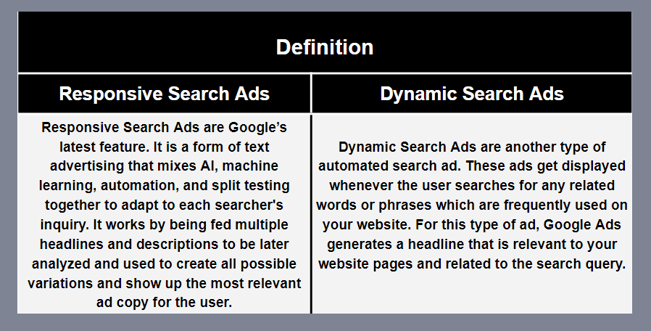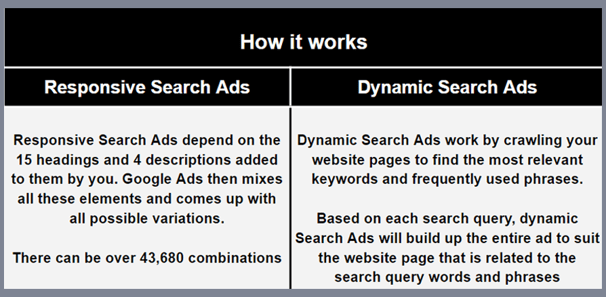Responsive Search Ads vs. Dynamic Search Ads (Full Comparison)
Google Ads has been adding multiple features to help business owners with search engine marketing. Two important features are responsive search ads and dynamic search ads. These two options utilize AI and automation to maximize results for business owners and help them reach out to more customers. In this article, we help you understand how to use these two great options to grow your E-commerce business. Furthermore, we will draw a comparison between responsive ads and dynamic ads so you understand the best ad type to use based on your business needs and goals.
Table of contents:
- Definition of Responsive Search Ads and Dynamic Search Ads
- How do Responsive Search Ads and Dynamic Search Ads work
- Benefits of Responsive Search Ads vs. Dynamic Search Ads
- Limitations of Responsive Search Ads vs. Dynamic Search Ads
- When to use Responsive Search Ads vs. Dynamic Search Ads?
- Differences In the structure of Responsive Search Ads vs. Dynamic Search Ads
Responsive Search Ads vs. Dynamic Search Ads (Full Comparison)
1- Definition of Responsive Search Ads and Dynamic Search Ads
-
Responsive Search Ads definition
Responsive Search Ads are Google’s latest feature. It is a form of text advertising that mixes AI, machine learning, automation, and split testing together to adapt to each searcher's inquiry. It works by being fed multiple headlines and descriptions to be later analyzed and used to create all possible variations and show up the most relevant ad copy for the user.
-
Dynamic Search Ads definition
Dynamic Search Ads are another type of automated search ad. These ads get displayed whenever the user searches for any related words or phrases which are frequently used on your website. For this type of ad, Google Ads generates a headline that is relevant to your website pages and related to the search query.

2- How do Responsive Search Ads and Dynamic Search Ads work?
-
Responsive Search Ads:
Responsive Search Ads depend on the 15 headings and 4 descriptions added to them by you. Google Ads then mixes all these elements and comes up with all possible variations.
There can be over 43,680 combinations. Google Ads will later bring up the most relevant combination for each user based on many factors, including their search query, device, location, browsing behavior, etc.
-
Dynamic Search Ads:
Dynamic Search Ads work by crawling your website pages to find the most relevant keywords and frequently used phrases.
Based on each search query, dynamic Search Ads will build up the entire ad to suit the website page that is related to the search query words and phrases. You can only write the descriptions and choose which pages users get directed to.

3- Benefits of Responsive Search Ads vs. Dynamic Search Ads
Responsive Search Ads benefits:
- Visibility to a wider audience: The ads are customized to the different users' search queries.
- Personalization: Through machine learning, Google ads analyze the user demographics and browsing behavior as well as their search query and show the right ad copy for them.
- More flexibility: Three headlines can be used, compared to two. Plus, two 90-character fields for descriptions.
- It saves time: Over 4000 descriptions are done through AI. Google ads also quickly find the most relevant combinations.
- Stronger performance: Responsive Search Ads can generate as much as a 10% higher clicks and conversions than normal search ads, according to Google.
Dynamic Search Ads benefits:
- Drives more relevant traffic: Dynamic search ads attract qualified traffic to your website because they dynamically generate headlines that are closely aligned with the user’s search term.
- It saves time: The ads get automatically generated without the need to map your bids, keywords, or ad copy to each specific page and product on the website.
- Targeted advertising: You get to decide which pages, products, categories, or landing pages to direct the traffic from the ads to. This achieves better targeting for smaller segments of your audience.
4- Limitations of Responsive Search Ads vs. Dynamic Search Ads
Responsive Search Ads Limitation:
- Possibility for Non-sense headlines: Google ads automatically select headlines and descriptions in any order or combination. Unless you ensure all copy is strong and logical as well as unique and different, you’ll end up with redundant and non-sense headlines.
- Limited control: Because of the use of automation, you can't control what variations will be built up by Google ads and which ones will appear to users.
- untrackable performance of individual ad copies: There is no report available to list which combinations are triggered on specific user queries and how well each combination performed.
Dynamic Search Ads limitations:
- Need regular site maintenance: Google ads crawl your website for keywords and phrases. If your website is not updated regularly, you will miss out on the potential of dynamic search ads.
- Destination pages must have good content: When choosing your target pages, products, and categories; you need to review their content closely. Otherwise, you may end up with irrelevant content being served to your viewers. You want to avoid any disharmony between the ad copy and destination page content.
- Lack of customization: With dynamic search ads, the headlines are auto-generated by the platform which leaves no room for creativity and customization.
5- When to use Responsive Search Ads vs. Dynamic Search Ads?
-
When to use responsive search ads?
Responsive Search Ads are the best option during the brand awareness stage and for lead generation. The personalized format will help you drive more impressions and attract more visitors because of the relevance between user search queries and your ad copy. The key benefit here is automation and testing which saves you time and maximizes results.
-
When to use dynamic search ads?
Dynamic Search Ads are the best option for attracting a targeted audience with narrow segments to the website. The reason is that this type of ad relies heavily on the keywords and the content of your website more than the ad copy itself. Dynamic Search Ads can work for both targeting new visitors or retargeting previous website visitors.
6- Differences In the structure of Responsive Search Ads vs. Dynamic Search Ads
- Headlines:
- Responsive Search Ads: Up to fifteen headlines added by you. They are thirty-character each.
- Dynamic Search Ads: Headline auto-generated by Google based on the keywords and phrases on your website. They can't be customized.
- Description:
- Responsive Search Ads: Up to four descriptions; up to 90 characters. Depending on the screen size, one or two descriptions can be displayed at a time.
- Dynamic Search Ads: Two descriptions, up to 90 characters. These two descriptions will be used with all generated headlines and URLs.
- Final URL:
- Responsive Search Ads: You can choose any final URL with no limitations.
- Dynamic Search Ads: Google ads generate the final URL based on the keywords used on a certain destination page.
Final thoughts:
You need to take the time to understand your marketing goal to choose the type of Google ad that will help you reach that goal. Think of the benefits and limitations of each type to build a strong campaign. A great step would be to study closely your customer segmentation to be able to build the right ads and write the most relevant descriptions or headlines.
Converted.in help you with customer segmentation and Google ads automation. Request a demo now!
 By
By
